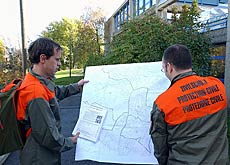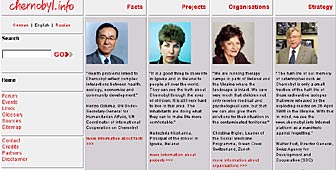Swiss assess effects of Chernobyl disaster

Twenty years after Chernobyl, Switzerland is still affected by higher than normal rates of radioactivity, with up to 200 deaths from cancer a direct result.
The southern canton of Ticino still bears the brunt of the worst accident in nuclear history, the Federal Health Office said on Tuesday.
High radioactivity was still being registered in wild mushrooms and meat.
The health effects of the Russian accident remain unstudied to a large degree, although there is not thought to be any significant danger.
“We still need another five to ten years to be able to make any meaningful statements,” said Jean-Michel Lutz, an epidemiologist from the Swiss Cancer League.
He was speaking at the Chernobyl: 20 years after, epidemiology and health consequences conference, which took place in Bern earlier this year.
Since the nuclear meltdown on April 26, 1986 at the Chernobyl nuclear power plant in Ukraine (then part of the Soviet Union), scientists have been looking into the long-term health consequences on the population.
Their studies have focused on cancer, but the statistics aren’t particularly informative and studies contradict one another. Definite trends are therefore hard to spot.
Other experts at the conference added that the subject material is highly complex and that the chance of developing cancer increases with age.
What’s more, the Cancer League is organised by canton and since not all cantons keep records, statistics only apply to 60 per cent of the population.
Also, it has been estimated that the additional long-term contamination in Switzerland caused by Chernobyl is one 240th the level of natural radioactive contamination. The Federal Health Office therefore calculates that the rise in cancers as a result of the accident is less than 0.05 per cent.
These projections are based on risk factors drawn up by the International Commission on Radiological Protection using statistics from survivors of the Hiroshima and Nagasaki atomic bombs.
Swiss reaction
Four days after the explosion the radioactive cloud reached Switzerland. Italian-speaking Ticino was the most affected as it rained there on the same day.
Swiss authorities promptly banned fishing on Lake Lugano and recommended that pregnant and breast-feeding mothers and small children avoid fresh milk and vegetables.
Sheep and goats in Ticino got a slaughtering reprieve until the end of August. Milk from Ticinese cows was transported to central Switzerland and used for cheese, cream and butter.
It was argued that the radioactive iodine isotope in the milk would have broken down by the time the product was put on the shelf – the contaminating iodine-131 has a half-life of eight days – and only negligible amounts of caesium would have affected dairy products.
“There’s no way that would be done today,” Werner Zeller, head of radiation protection at the Federal Health Office, told swissinfo. “Producers and consumers would definitely have been affected somehow.”
Traces of caesium-137, a radioactive isotope with a half-life of around 30 years, are still detectable in Ticino and there are some concerns that contamination is migrating into underground aquifers.
However, wild boars and mushrooms in Ticino show generally harmless levels of caesium.
Room for improvement
The Chernobyl catastrophe no longer seems to be an issue for the Swiss public. “Caesium has a much longer life than people’s memories,” noted Zeller, who said radiation protection and readings had improved significantly over the past two decades.
He also pointed out that people living within 20km of atomic power plants have recently been supplied with potassium iodide tablets, which flush out the radioactive iodine-131 fission product after fission has taken place.
One area however where Zeller thinks Switzerland could do better is crisis management.
“An atomic accident could happen at any time,” he said. “And rehearsals have shown that there is still room for improvement here.”
swissinfo, Andreas Keiser and agencies
On April 26, 1986 a reactor at the Chernobyl nuclear power plant in Ukraine melted down, sending a cloud of radioactive fallout over parts of the western Soviet Union, eastern Europe, Scandinavia, Britain and the eastern United States.
Ticino reported the highest levels of radioactivity in Switzerland.
Swiss authorities banned fishing on Lake Lugano and recommended that pregnant and breast-feeding mothers and small children avoid fresh milk and vegetables.
The government later had to compensate fishermen and farmers for loss of income.
A 2005 report by the International Atomic Energy Agency attributes 56 deaths directly to the meltdown (47 accident workers and nine children with thyroid cancer).
It also estimates that as many as 4,000 people may ultimately die from long-term accident-related illnesses. Greenpeace, among others, disputes the study’s conclusions.
Some experts think it won’t be possible to put a figure on the number of victims before 2016.
Swiss health experts estimate that the disaster led to 200 extra cancer deaths in Switzerland.

In compliance with the JTI standards
More: SWI swissinfo.ch certified by the Journalism Trust Initiative











You can find an overview of ongoing debates with our journalists here . Please join us!
If you want to start a conversation about a topic raised in this article or want to report factual errors, email us at english@swissinfo.ch.